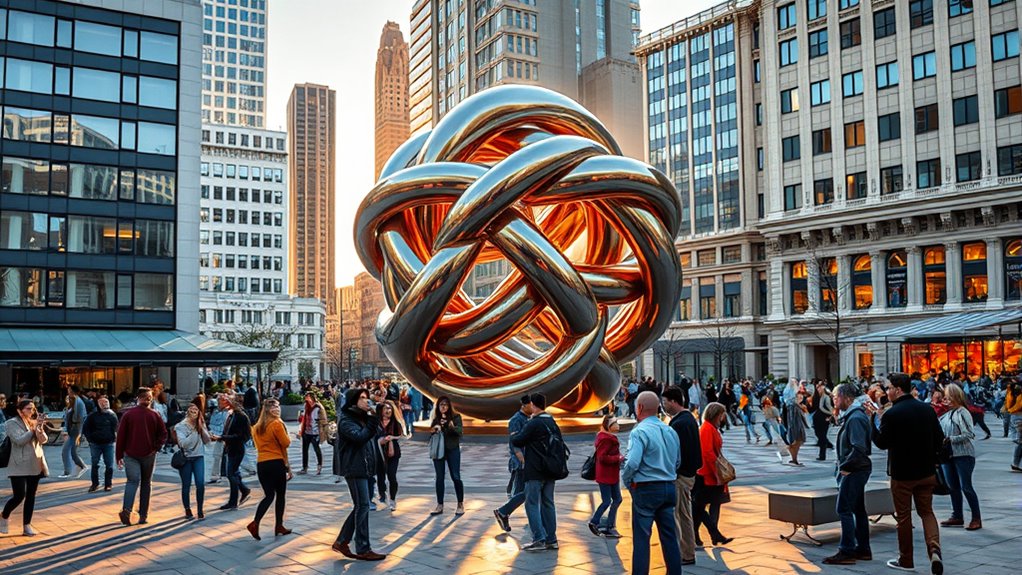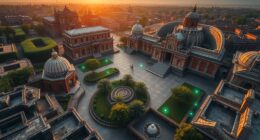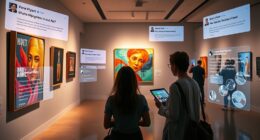Public art projects can markedly boost your local economy by attracting more visitors, increasing foot traffic to nearby businesses, and raising property values. They also foster community pride and urban renewal, which can lead to further investments and tourism. With diverse funding options like government grants, private donations, or crowdfunding, these projects become sustainable and impactful. Exploring this further reveals how strategic investments in public art can create lasting economic and social benefits for your community.
Key Takeaways
- Diverse funding models, including government grants, private sponsorships, and crowdfunding, influence project sustainability and scope.
- Public art attracts tourism and foot traffic, boosting local businesses and generating economic growth.
- Strategic placement of public art enhances neighborhood appeal, property values, and urban renewal efforts.
- Long-term benefits include job creation, increased tax revenues, and improved community cohesion.
- Effective documentation and promotion of public art projects can maximize economic impact and community engagement.

Public art is more than just visual embellishment; it’s a strategic investment that influences local economies and community well-being. When you consider funding models for public art projects, you’re engaging with a variety of options that directly impact their success and sustainability. Public art funding can come from government grants, private donors, corporate sponsorships, or community-based crowdfunding. Each model offers distinct advantages and challenges. Government funding provides a steady stream of resources but often involves complex bureaucratic processes. Private donors and corporate sponsors can inject significant capital quickly, but their interests might influence the artistic direction. Crowdfunding taps into community support and engagement, fostering a sense of ownership, yet it may not raise enough to cover large-scale projects. Understanding these funding models helps you gauge the potential economic impact of public art. Well-funded projects tend to attract more visitors, generate foot traffic, and stimulate local businesses like cafes, shops, and hotels. When you see a striking mural or sculpture, you’re witnessing an investment that can transform a neighborhood, boosting its economic vitality. The economic impact of public art extends beyond immediate spending; it’s about creating a vibrant environment that encourages tourism, increases property values, and enhances quality of life. For instance, a thoughtfully placed sculpture or mural can turn a neglected space into a popular destination, drawing tourists and locals alike. This influx of visitors translates into increased spending at nearby businesses, which can lead to job creation and higher tax revenues for the community. Furthermore, public art projects often catalyze further development, encouraging real estate investments and urban renewal initiatives. When you participate in or support public art, you’re contributing to a cycle of economic growth fueled by cultural enrichment. Cities that prioritize diverse funding models tend to see more sustainable and impactful public art initiatives, which in turn generate lasting economic benefits. These projects become catalysts for community pride and social cohesion, making neighborhoods more attractive to new residents and investors. As you explore or support public art, keep in mind that its economic impact isn’t just about the immediate visual appeal; it’s about the long-term benefits that shape the economic landscape of your community. When done strategically, public art can serve as an engine for economic development, revitalizing areas and fostering a sense of shared identity. By understanding and leveraging various funding models, you help ensure these projects remain sustainable and impactful, enriching your community far beyond their visual presence. Recognizing the importance of sound recording techniques and equipment in documenting and promoting public art projects can further enhance their visibility and community impact.
Frequently Asked Questions
How Do Public Art Projects Impact Local Property Values?
Public art projects can boost your local property values by enhancing community engagement and aesthetic appeal. When you see vibrant murals or sculptures, it creates a sense of pride and attracts visitors, which can lead to increased demand for nearby homes. As your neighborhood becomes more attractive and lively, property values tend to rise, making it a win-win for residents and investors alike, fostering a stronger, more connected community.
What Funding Sources Are Most Common for Public Art Initiatives?
You often find public art initiatives funded through private grants and corporate sponsorships. Private grants come from foundations or organizations dedicated to supporting the arts, providing essential financial backing. Corporate sponsorships involve local businesses or corporations investing in public art to boost community engagement and visibility. These sources are popular because they offer substantial funding without relying solely on public government budgets, making them vital for activating and sustaining public art projects.
How Is the Success of a Public Art Project Measured Economically?
You wonder how to gauge the economic impact of a public art project, don’t you? It starts with art investment returns—visitor numbers, local business boosts, and increased property values. These indicators reveal success, but the true measure lies in long-term community engagement and cultural enrichment. When these factors grow, your project’s economic impact shines, proving that art isn’t just beauty—it’s a powerful economic engine.
Do Public Art Projects Generate Long-Term Economic Benefits?
Yes, public art projects can generate long-term economic benefits. They often lead to economic revitalization by attracting tourism, which boosts local businesses and creates jobs. When you invest in public art, you enhance the area’s cultural appeal, drawing visitors and residents alike. Over time, this increased foot traffic and visibility contribute to sustained economic growth, making your community more vibrant and economically resilient.
How Do Cities Decide Which Public Art to Commission?
Cities decide which public art to commission by considering artistic criteria like originality, relevance, and quality, ensuring the work aligns with local culture and aesthetics. They also prioritize community engagement, selecting pieces that resonate with residents and encourage participation. Public input, budget constraints, and the artist’s reputation influence decisions. Ultimately, cities aim for artworks that enhance public spaces, foster community identity, and reflect local values.
Conclusion
So, as you step back to view a public art project, remember it’s more than just a pretty statue—think of it as your modern-day Rosetta Stone, revealing community value and economic growth. You might not see the immediate gold, but like the first printing press, these projects can spark a cultural revolution. Embrace the investment, because in the grand scheme, public art turns cityscapes into timeless masterpieces—proof that art and economics can dance in harmony.










